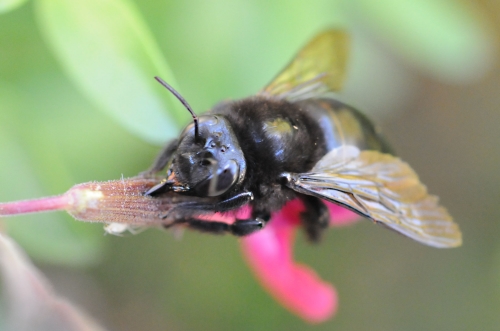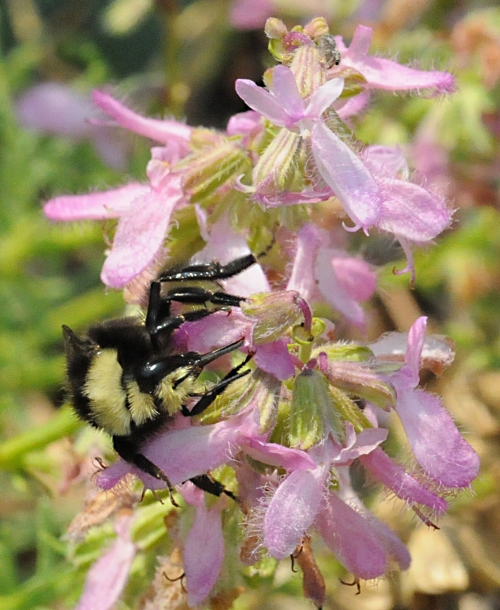- Author: Kathy Keatley Garvey
If you were a queen bee, you'd be laying about 1500 to 2000 eggs today. It's your busy season.
"She's an egg-laying machine," said bee breeder-geneticist Susan Cobey of the Harry H. Laidlaw Jr. Honey Bee Research Facility at UC Davis. "And she's the mother of all the bees in the hive." During the peak season, that amounts to about 50,000 to 80,000 workers (sterile females) and 1000 to 2000 drones (males).
Worker bees take care of her every need. They feed her, groom her and protect her, Cobey said, "and then they have the additional tasks of rearing and feeding her young."
The queen bee is easy to spot in the hive; she's the biggest bee. And wherever she goes, you'll see her court (workers) surrounding her.
Beekeepers mark her with a colored dot on her thorax so she's easily visible. (School children, when asked to single out the queen bee, say "She's the one with the dot!")
On her maiden flight, the queen bee mates with some 12 to 25 drones and then she heads back to the hive to lay eggs for the rest of her life, "usually two or three years," said Cobey, who is internationally renowned for her classes on "The Art of Queen Rearing" and "Instrumental Insemination and Bee Breeding."
The queen bee destroys any and all competitors for her "throne" by stinging and killing them. Unlike worker bees, she does not die after she stings.
Interestingly enough, only female bees can sting. Drones, or male bees, have no stingers (despite what Jerry Seinfeld's character said in The Bee Movie). Their only purpose is to mate with the queen. Then they die.
It's a matriarchal society. The girls (worker bees) do all the work; they serve as nurses, guards, grocers, housekeepers, construction workers, royal attendants and undertakers. It's not surprising, then, that during the summer, their life span is only four to six weeks.
Meanwhile, if you're the queen bee, there's no reproductive rest for you! You have about 1,999 more eggs to lay today.
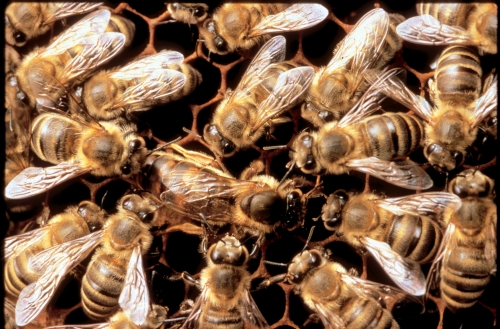
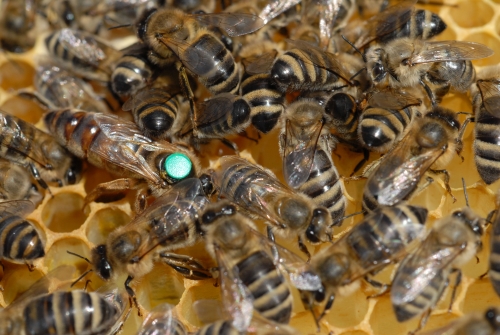
- Author: Kathy Keatley Garvey
"Omigosh, what's that? A gray hairstreak?"
If it's in your hair, you consult a mirror, your favorite salon, or just ignore it.
If you're an entomologist or a lepidopterist, a gray hairstreak is delightful. "Omigosh, check that out! A gray hairstreak!"
A gray hairsteak is a butterfly (Strymon melinus). It's basically gray with a large orange spot near its tail. It probably derives its name from the fine gray hairlike markings that cross the undersurface of the hind wings. If you look closely, you'll see threadlike tail projections, resembling antennae.
It's not a beautiful butterfly, as butterflies go, and oh, do they go! Fast and low-flying, it is difficult to photograph. If you catch it nectaring, that's your best shot.
In its caterpillar stage, it damages bean, corn and cotton crops.
Renowned butterfly expert Art Shapiro of UC Davis, who maintains an excellent butterfly Web site, says hairstreaks belong to the subfamily (Theclinae) and the gossamer-wing butterfly family (Lycaenidae).
"The gossamer-wings are a very diverse and complex family with at least 4750 species worldwide," he says. "In California, they can be grouped into the coppers (subfamily Lycaeninae), the blues (subfamily Polyommatinae), and the hairstreaks (subfamily Theclinae)."
The gray hairstreak is considered a weedy butterfly. "Weedy," as Shapiro explains on his Web site, "is a general term for organisms that are typically associated with habitats that are disturbed by human activities or are dominated by non-native, invasive plants."
Adults visit an immense variety of flowers, both wild and cultivated, says Shapiro. Indeed, the gray hairstreak is one of the most polyphagous butterflies known; it feeds on scores of different flowering plants.
In our bee friendly garden, a male gray hairstreak nectared last weekend on sage, sharing it with assorted honey bees.
Then like a streak, he was gone.
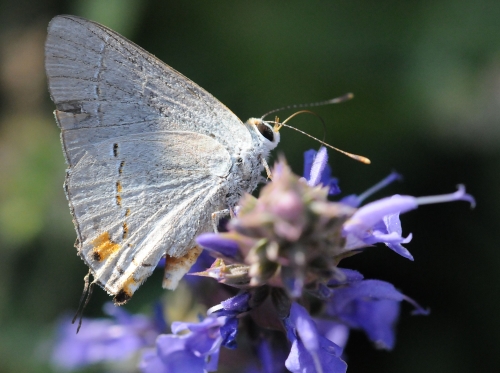
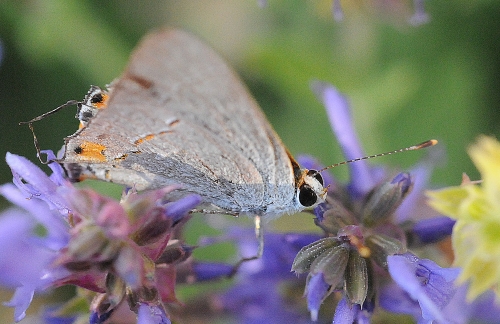
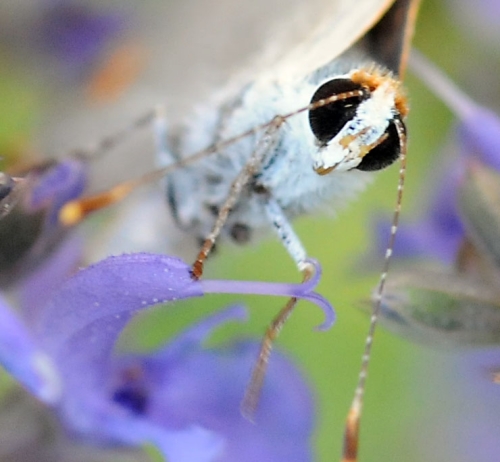
- Author: Kathy Keatley Garvey
Build it and they will come.
Baseball's “Field of Dreams?”
No, a bee nesting block. Think "bee condo."
It's an artificial nesting site made of wood and drilled with different-sized holes and depths to accommodate the diversity of native pollinators. Often the bee block is nailed to a fence post. Native bees, such as leafminer bees and blue orchard bees, build their nests inside the holes.
Fact is, North America is home to about 4,000 species of native bees. (The common honey bee is not a native; colonists brought it here from Europe in the 1600s.)
Members of the Xerces Society, an international organization "dedicated to protecting biological diversity through invertebrate conservation," are keen on protecting the habitat of native bees and other native invertebrates. As part of their public outreach program, they publish books, pamphlets and fact sheets. These include Pollinator Conservation Handbook, Farming for Bees, and the fact sheet, Bumble Bees in Decline.
As for the bee condos, thousands are sold each year in the United States, according to entomologist Mace Vaughan, pollinator program director of the Xerces Society, based in Portland, Ore. As concern for the environment grows, more and more farmers and urban gardeners want to attract and accommodate the native bees. Native bees are important crop pollinators, Vaughan says, and the work people do on behalf of the pollinators also supports other beneficial insects and wildlife.
Vaughan, who escorted a group of us on a recent Yolo County farm tour, said many of our native bee species are much more efficient than honey bees at pollinating some crops.
"For example, only 250 female orchard mason bees (genus Osmia, also called blue orchard bees) are required to effectively pollinate an acre of apples, a task that would require 1.5 to 2 honey bee hives--approximatley 15,000 to 20,000 foragers." (Source: Farming for Bees, a Xerces Society publication.)
Native bees sport such names as miner, carpenter, leafcutter, mason, plasterer or carder, reflecting their nesting behaviors.
See the bee (below) heading toward the bee block? Xerces Society member Robbin Thorp, emeritus professor of entomology at UC Davis who researches native pollinators, including bumble bees, says this is a female leafcutting bee, "probably the introduced Megachile apicalis, a specialist on Centaurea species, especially yellow starthistle."
The leafcutter bee, as its name implies, cuts leaves to form its nest.
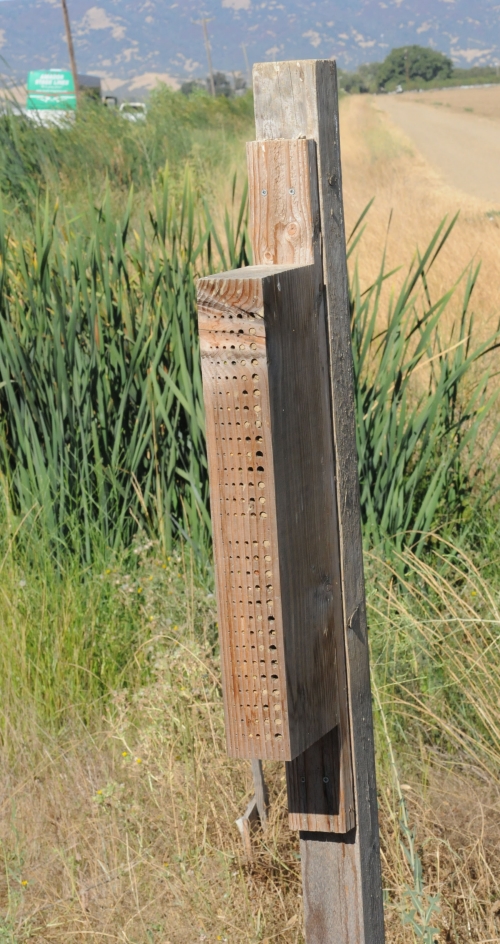

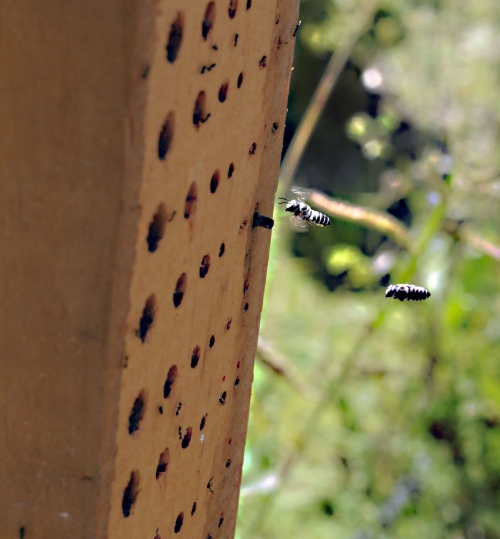
- Author: Kathy Keatley Garvey
We've all heard of the cuckoo clock.
And most of us have heard of the cuckoo bird (Cuculus canorus), which lays its eggs in the nest of birds of other species.
But the cuckoo bee?
Yes, there is a cuckoo bee. The female lays her eggs in the nests of other solitary nesting bees.
They resemble wasps. You can see these slender-waisted bees hovering low to the ground, sneakily searching for burrows of other solitary nesting bees.
Like an identity thief, they try to avoid detection. They slip into a a burrow and lay their eggs in the host's nest. The hatched larvae then eat the host's food and parasitize (kill and eat) the host's larvae.
Some cuckoo bees are more abrupt and don't smuggle their eggs into a nest. In Insects of the World, Walter Linsenmaier writes how a few species of Sphecodes, invade the nests of mining bees (Halictus), and "with naked force when necessary" slaughter "everything that opposes them."
Then the cuckoo bee flings the opposition out the entrance. Did anybody say "cruel world?"
Cuckoo bees are not nice and they're not ready to make nice. If this is a world of The Givers and The Takers, then they're the takers.
I captured this image of a cuckoo bee last week. Said Robbin Thorp, emeritus professor of entomology at UC Davis: "It's a cuckoo bee, probably the genus Triepeolus (maybe Epeolus) and probably a male."
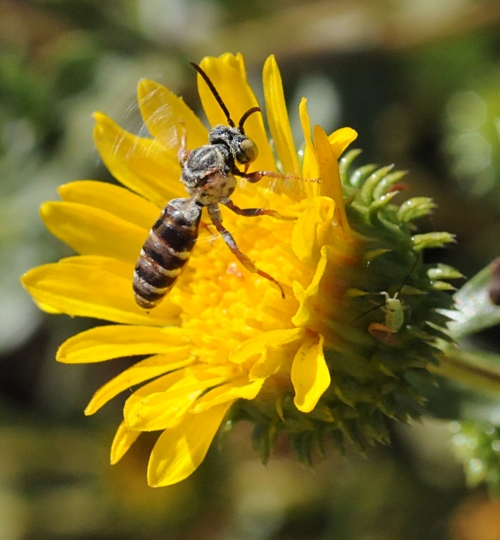
- Author: Kathy Keatley Garvey
Robber at work.
No, this isn't a bank heist or a gas station hold-up or a home invasion.
A carpenter bee is slitting the sides of salvia (sage) to steal the nectar.
Floral larceny! Book 'em, Danno!
Carpenter bees are nectar robbers. Nectar robbers pierce or bite into the corolla of a flower to remove the nectar. They can be birds, insects or other flower visitors.
But wait, nectar robbers aren't all that bad. They pave the way for our beloved honey bee to gather nectar.
The carpenter bee is often mistaken for a bumblebee because of its size and color. The most striking difference: the carpenter bee's abdomen is shiny, smooth and black, while the bumblebee's abdomen is fuzzy, covered with dense black and yellow hairs.
Unlike the bumblebee, the carpenter bee is a pest. To make its nest, the C-bee tunnels into wood, often weakening structures. It's a fairly decent pollinator, however, when it lands on open-faced flowers.
The C- bee can't creep into a tubelike flower to steal nectar, so it bites a hole into the corolla with its proboscis. It's a show of force. An end run. Touchdown!
If you see a floral larceny in process, don't dial 9-1-1 or consult Section 211 of the Penal Code. Just think of our besieged, beleagured and embattled honey bees that will benefit from this "act of crime."
